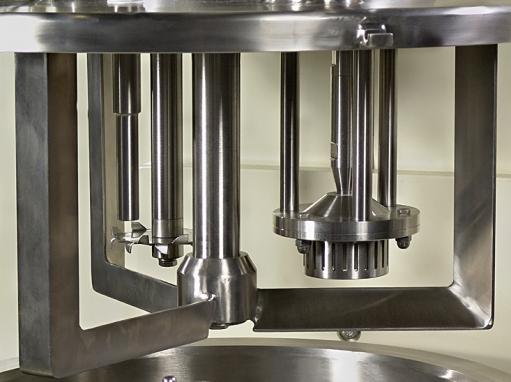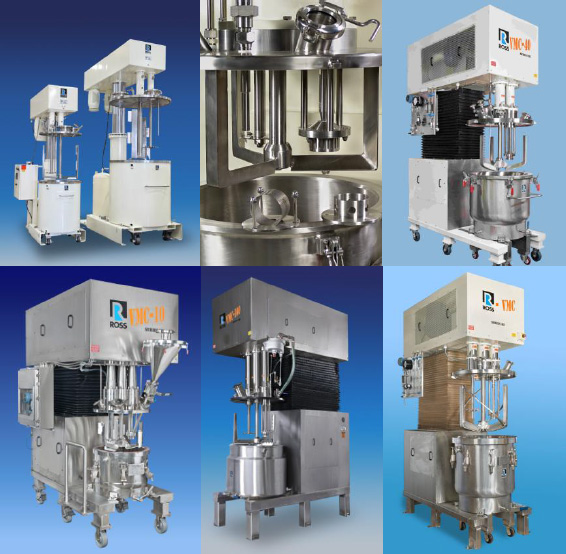Tech Report
Recommended Mixing Equipment Metal Soap Dispersions

Application Summary
Metal soaps such as calcium stearate and zinc stearate are available in the form of a powder or a dispersion containing high percent solids. The latter is preferred in certain industries because it is easier to handle and mix into water-based systems.
One typical method of producing metal soaps is to blend calcium hydroxide or zinc oxide powders into melted stearic acid in a reactor. This yields metal stearate which may then be filtered, dried and milled into powder form. To produce a fine dispersion, the powders are further processed in a high shear mixer or high pressure homogenizer.
This bulletin describes a more efficient alternative procedure in the Ross Multi-Shaft Mixer, a versatile reactor designed not only for thorough blending and superior temperature control but also high shear dispersion and particle size reduction.
Ross Multi-Shaft Mixers/Reactors
Ross Multi-Shaft Mixers are ideal equipment for the preparation of metal stearates. Equipped with three independently-driven agitators working in tandem, Multi-Shaft Mixers deliver a robust combination of laminar bulk flow and high shear agitation within a wide viscosity range: from water-like consistency to several hundred thousand centipoise.
A typical Multi-Shaft Mixer configuration features a low-speed anchor agitator, a high-speed saw-tooth disperser blade and a rotor/stator assembly. A sample mixing procedure starts with charging the water, minor liquid components and stearic acid, a waxy material that melts into a low-viscosity liquid. Heating fluid is circulated through the jacketed vessel and the anchor agitator scrapes the sidewalls to optimize heat transfer. At this stage, the disperser and rotor/stator are set at relatively low speeds, just enough to promote the exchange of batch materials within different areas of the vessel. When the stearic acid is sufficiently melted and the target temperature is achieved, calcium hydroxide powders are added through the mixer cover. Agitator speeds are gradually increased to accommodate changes in viscosity, temperature and product turnover.
Once the exothermic reaction is complete, a cool down step is performed with all the agitators running at reduced speeds again. In the final mixing stage, vacuum is established to remove entrapped air from the product and the high shear rotor/stator is run at full speed to generate a fine particle size distribution.
Other Applications of Ross Multi-Shaft Mixers:
- Battery Slurries
- Beverages
- Creams and Lotions
- Dietary Supplements
- Filled Epoxies
- Flavorings
- Greases and Lubricants
- Gum Dispersions
- Hair Colors
- Hot-Melt Adhesives
- Inks and Coatings
- Liquid Make-Up
- Medical Gels
- Metal Slurries
- Ointments
- Rubber Solutions
- Sealants
- Solder Pastes
- Suspensions
- Syrups and Sauces
- Toothpaste
- Transdermal Patches
- Wax Emulsions

Advantages of Ross Multi-Shaft Mixers/Reactors
- Versatility. Equipped with independently-controlled drives, the agitators in a Multi-Shaft Mixer can be engaged in any combination and at any speed for any interval during the mixing cycle. The combined mixing and heat transfer capabilities of each agitator results in a very robust system that can handle a wide range of viscosities.
- Protection against contamination. The Multi-Shaft Mixer is a closed system with no bearings or agitator seals submerged in the mixing area. Self-adjusting scrapers and flush discharge valves eliminate dead zones where product can stagnate.
- Cleanability. With change-can design Multi-Shaft Mixers, the agitators are raised and lowered by a hydraulic lift allowing easy access for cleaning between batches. CIP rotary spray nozzles may also be supplied.
- Scalability. Standard and sanitary models from 1 to 3000 gallons working capacity are available in both vacuum and atmospheric designs.
- Customers can rely on Ross for customizations and auxiliary equipment including custom sight/charge ports, interchangeable blades and mix vessels, load cells, temperature probes, heating units, vacuum pumps and controls ranging from simple Variable Frequency Drives and Operator Stations to more sophisticated PLC`s and HMI`s.